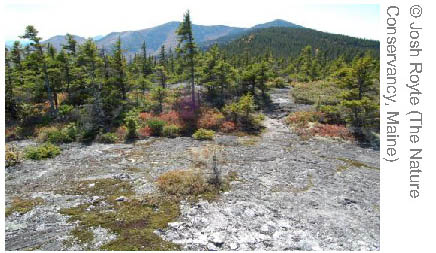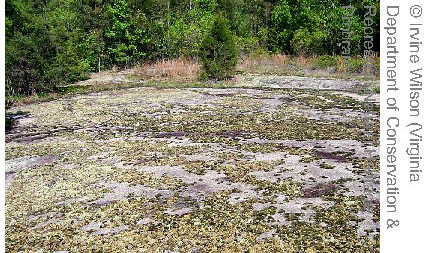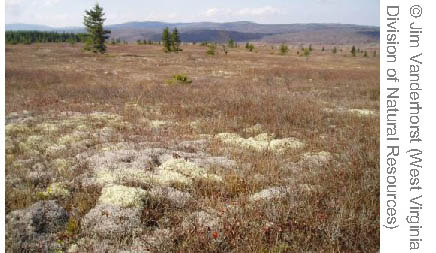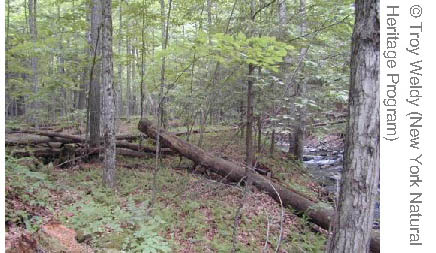The Outcrop and summit scrub macrogroup consists of the following habitats:
Acidic Rocky Outcrop


Regional distribution:
CT, MA, ME, NH, NY, VT. 197,404 total acres of habitat, of which 55.9% is conserved.
Description:
A sparsely vegetated system on resistant acidic bedrock such as sandstone, quartzite, or granite. The vegetation is a mosaic of woodlands and open glades reflecting the proportion of rock surface to thin soil. At higher elevation or in northern regions characteristic trees, sometimes stunted, include black spruce, red pine, red oak, and scarlet oak. Carpets of low heath shrubs or reindeer lichens are typical. At low to mid elevation stunted red oak, white pine, and red spruce are characteristic over low heath shrubs such as lowbush blueberry, huckleberry, and chokeberry. An open jack pine/heath shrub woodland community on nearly level sandstone pavement in northeastern New York falls into this system. Lichens, mosses, and scattered herbs dominate the ground cover.
Download the
pdf for this habitat for information about species, crosswalks to state names, and condition of this habitat.
Southern Piedmont Granite Flatrock & Outcrop


Regional distribution:
VA. 83 total acres of habitat, of which 28.0% is conserved.
Description:
A sparsely vegetated smooth outcrop of massive granite and related rocks in the south central Piedmont of Virginia. The vegetation is a complex of different species and structure occupying different microhabitats present on the outcrops (thin soil mats, seasonal pools, bare rock), ranging from moss and lichens to herbs to shrubs and a few trees. Occurring most commonly near streams where erosion has left smooth rock and small gravelly depressions, in some areas these microhabitats include solution pits or depressions that retain water and form a distinctive wetland community. Examples of this small patch system are from one to a few acres.
Download the
pdf for this habitat for information about species, crosswalks to state names, and condition of this habitat.
Southern Appalachian Grass and Shrub Bald


Regional distribution:
WV. 3,198 total acres of habitat, of which 71.5% is conserved.
Description:
An open shrubland or grassland of high-elevation summits and upper slopes in the southern Appalachians. Shrub- dominated balds are a mosaic of evergreen or mixed shrubland dominated by catawba rhododendron with mountain-laurel and black huckleberry, and deciduous shrubland dominated by blackberry or American mountain- ash, minniebush, and southern mountain-cranberry. Common herbs in open areas are mountain oat-grass, various sedges, and forbs likes three-toothed cinquefoil and Blue Ridge St. Johns-wort.
Download the
pdf for this habitat for information about species, crosswalks to state names, and condition of this habitat.
Calcareous Rocky Outcrop


Regional distribution:
ME, NH, NY, VT. 50,770 total acres of habitat, of which 51.5% is conserved.
Description:
A sparsely vegetated ridge, summit, dome, or flat plain, composed of circumneutral or calcareous bedrock such as limestone or dolomite The vegetation is a mosaic of woodlands and open glades reflecting the proportion of rock surface to thin soil. Northern white cedar is a characteristic tree although it rarely forms extensive cover. Sites are often exposed and dry; however, there may be local areas of more moist conditions.
Download the
pdf for this habitat for information about species, crosswalks to state names, and condition of this habitat.